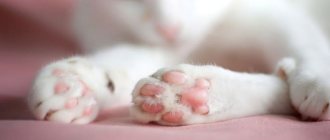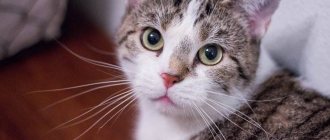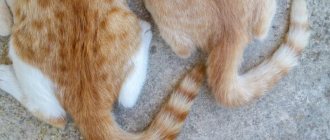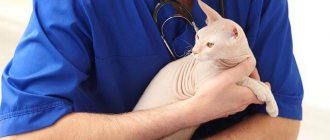Contrary to popular belief, cats do not have nine lives. And they don't always land on their feet. In fact, they are much more vulnerable than you think.
In addition, they may suffer from a variety of health problems similar to those experienced by humans. One such problem is front leg lameness.
As kittens age, they weaken and their general health deteriorates. Besides the obvious condition of your cat's skin and coat, one of the most common signs of aging hairballs in cats is lameness.
Why does a cat limp on its front leg?
In most situations, lameness on the front paw indicates the non-contagious nature of the pathology.
The following are the reasons why a domestic cat falls on its front limb:
- Injuries: sprains, bruises, fractures, punctures, cuts, dislocations, dog bites, splinters. In most cases, upon examination, a wound or swelling is discovered.
- Ankylosing spondylosis , called by analogy with the human disease osteochondrosis. Develops in kittens and older pets. Young animals suffer due to the owners' addiction to overfeeding liver or uncontrolled use of vitamin preparations. Hypervitaminosis A causes excessive calcification and fusion of the vertebrae. The nerves are pinched and the cat begins to limp.
- Arthritis, arthrosis. The disease is typical for older animals in which the cartilage on the articular joints has worn out.
- Dysplasia (improper development, deformation) of the elbow joint. Hereditary disease of large cats. The development of pathology is facilitated by excess weight, adynamia, and excess protein in the diet.
- Osteomyelitis is inflammation of the bones. Most often, fingers are affected when opportunistic microflora (staphylococci) enter the site of a bite or puncture.
- Side effects of injection medications. If a cat is given an injection in the front paw, a pain reaction may develop, which spontaneously disappears after a few days.
Joint diseases
Lameness can be caused by a congenital abnormality of the structure of the joints - dysplasia. In this case, the animal will have difficulty stepping on the affected limb from childhood. Other joint pathologies include arthritis and degenerative changes in the joints of the front paws. As a rule, such diseases are rare and mainly occur in older cats with metabolic disorders, acromegaly or obesity.
Symptoms indicating problems with the front paw of a pet:
- Change in gait.
- Refusal to jump on chairs and other surfaces.
- Lethargy.
- Frequent licking of the sore limb.
When the owner tries to touch the sore paw, the cat reacts sharply, pulling it away, running away or hissing. If this condition persists for more than a few days, you should contact your veterinarian as soon as possible. To make a diagnosis, the doctor will palpate and examine the affected limb. Radiography is mandatory.
Infectious causes of lameness in cats
Lameness on the front paw is a characteristic symptom of calicivirus, a viral disease that affects unvaccinated cats. Pets 2-24 months of age can get sick.
Be sure to read:
The cat has a fever: what to do, reasons, what is the norm, how to bring it down at home, the best methods
Additional symptoms:
- refusal to eat;
- ulcers and stench from the mouth;
- cough;
- runny nose;
- conjunctivitis.
Lameness occurs suddenly and disappears spontaneously. Another cause of infectious origin is fungal diseases that affect the claws. The horny formations become fragile, break, and it hurts the cat to walk.
Operation for advanced cases
After receiving an injury, the dislocation must be corrected as soon as possible. Delay in receiving medical help leads to muscle contraction, the formation of a dense blood clot and scar tissue. These changes make it difficult to reduce the dislocation using a closed method. In such cases, the question arises about surgical treatment of advanced dislocations.
During the operation, during which the animal is asleep, an incision is made in the joint area, through which fibrin clots and destroyed parts of the joint are removed. The joint returns to its original position; this will require force or special levers. A joint reduced openly also requires fixation and temporary immobilization.
DETAILS: Biceps tear - SportWiki encyclopedia
Sometimes a cat requires surgical fixation of a joint:
- for dislocations of the hip or wrist joints, it is carried out using special pins;
- for elbow and ankle - screws and wires.
Congenital dislocations in furry pets are usually eliminated using the open method. After a minor dislocation, the animal recovers within 3-4 days. The cat can use its paw, but has a slight limp. Full recovery from severe dislocations takes about 3-4 weeks.
In the best case, the entire injury will be reduced to micro-tears of the ligament fibers and will not require specific treatment, you just need to provide the pet with rest and care. Connective tissues quickly regenerate and your pet will come to its senses within 2–3 days.
If you are “lucky” and the sprain is associated with a dislocation of a joint or a broken bone, you will need the help of a doctor, and immediately. The damaged bone is set, and a fixing bandage or plaster is applied to the limb.
A cat is limping on its front leg: how to recognize a fracture or bruise
If the cat is limping, the owner needs to make a preliminary diagnosis in order to develop an algorithm for his subsequent actions.
When a fracture occurs, the following signs are observed:
- the paw swells along the entire length, and not just at the site of injury;
- upon palpation, displacement of the bone or joints is felt;
- the integrity of the skin may be compromised;
- the cat is in severe pain and meows all the time;
- the cat does not try to lean on the broken paw;
- the injured limb looks unnatural.
The bruise is characterized by the following symptoms:
- a hematoma appears at the site of the injury;
- the cat is leaning on a limb, but is limping;
- no displacement of bones or joints;
- skin integrity is preserved;
- the injury site is hot;
- the pet constantly licks the swelling;
- touching the paw causes aggression.
However, the final diagnosis is made by a veterinarian based on the results of an examination and x-ray.
Diagnostics
Neither successful treatment nor a reasonable prognosis for the affected cat is possible without an accurately established diagnosis.
Clinical examination
On the examination table, the doctor examines and carefully palpates the injured animal. Particular attention is paid to the preservation or absence of motor reflexes and pain sensitivity. Already at this stage, it is possible to approximately assess the location and extent of damage to the spinal cord.
Severe fractures of the spine are visible to the naked eye (back deformation, unnatural body position), but the doctor always sends a cat suspected of such a diagnosis for an x-ray examination.
X-ray
The good thing about X-rays is that the images can be taken without anesthesia and quickly provide additional information about the injury. Digital X-rays are not available everywhere, but not a single decent veterinary clinic can do without a conventional device.
The images will show tumors, fractures and vertebral displacements. In case of severe injuries, based on X-rays, it can be confirmed that the spinal cord is ruptured (a combination of fracture and dislocation of the spine). However, the nerve substance itself cannot be seen on an x-ray. Therefore, if the owners are ready for surgery and want to do everything possible, the cat will have to undergo a special diagnosis.
Contrast myelography
To make the spinal canal visible on x-rays and determine the location of its compression, a contrast agent is injected between the membranes of the spinal cord. The pet must be under anesthesia. After contrast is administered, a series of x-rays are taken at regular intervals.
The advantage of such research is its wide availability (no special equipment is required) and information content. However, compared to CT or MRI, myelography is more dangerous because it is an invasive diagnostic method. In 1-2 animals out of 100, it causes complications associated with increased intracranial pressure or accidental damage to a vessel with a needle and the formation of a hematoma.
Magnetic resonance imaging (MRI)
The gold standard for diagnosis for any spinal injuries is MRI, as it makes it possible to see in detail the nervous tissue of the spinal cord, the area and degree of damage, and compression. This study is performed under general anesthesia. An MRI should precede all spinal surgery (and helps determine whether such surgery is advisable at all).
The cat is limping on its front leg: what to do, treatment
If the pet rests on its paw, it does not have a fracture. When an animal is given an injection in the front paw, the lameness is explained by a painful reaction to the medication.
If after 24 hours the swelling has not subsided and the injury site is hot, a visit to the veterinarian is necessary. If you suspect a fracture, your pet should be taken to the clinic immediately and given first aid.
First aid for a cat
In the first minutes after a bruise, cold is applied to reduce blood flow and minimize the volume of hematomas. If 15-20 minutes have passed, the procedure is useless.
If a fracture is suspected, especially when the integrity of the skin is broken, the damaged area is cleaned of dirt with a soft cloth. Do not wash the wound with water. The site of injury is treated with Chlorhexidine or Miramistin, the limb is immobilized and taken to the clinic.
Be sure to read:
A cat bite has a swollen hand: what to do, first aid, why it is dangerous, how to treat it, what not to do
Drug therapy
If the injury occurs as a result of a cut, puncture, or a splinter has stuck into the paw, the foreign body is removed and the injured area is treated with an antiseptic. In such a situation, the limb heals in 2-3 days, and the lameness will disappear.
With the development of joint inflammation, pain can occur not only in the front paw. The veterinarian prescribes anti-inflammatory drugs and feed additives containing chondroprotectors.
Elderly animals, depending on their condition, are transferred to therapeutic food for cats suffering from musculoskeletal pathologies.
If the claw is damaged and test results show infection with fungi, external antifungal agents are prescribed. If the fall on the paw is caused by calcivirus, the veterinarian will use medications to treat the underlying disease. When the cause of lameness cannot be determined, antispasmodics or analgesics are used.
Surgical intervention
The clinic examines the damaged paw; if necessary, the veterinarian prescribes laboratory and instrumental tests.
If the claw is damaged, it is trimmed. In case of complex fractures or multiple fragmentation of bones, osteosynthesis surgery or amputation is suggested.
A kitten has a bruised paw: why is contacting our veterinarian the right decision?
Any mechanical damage, regardless of the cause, and a bruised paw in a kitten, is stressful for the animal and often causes serious problems later. In some cases, even a slight bruise of the first and second degrees does not go away without a trace for the cat.
If a kitten or adult cat has injured its paw and is limping, then a timely visit to the YA-VET veterinary emergency center will help deal with the injury as quickly as possible without consequences and expensive treatment.
. Correct diagnosis and qualified assistance from veterinarians who have extensive experience working with cats of any age guarantee that the injury will go away as soon as possible, and the pet will enjoy excellent health and the same activity!
We have everything necessary to ensure that mechanical damage to the limbs occurs with the least risk. Veterinary center specialists will find out why the animal is limping and prescribe effective treatment for a specific case. Veterinarians have modern diagnostic equipment, a full-fledged hospital, and their own laboratory at their disposal.
Call us and find out how much emergency veterinary care costs in order to order a visit from specialists without overpayments!
Achilles tendon rupture in dogs and cats
Rupture of the Achilles tendon (Rupturatendinis achillis) can occur as a result of an accidental cut or chopped-torn wound (wild boar tusk), as well as from a strong blow with the hoof of an elk or other domestic ungulates, when hit by moving vehicles, etc.
Clinical signs of a complete rupture of this tendon are characterized by flexion of the limb at the metatarsal joint and support of the entire plantar surface of the metatarsus on the ground. The movement is difficult and occurs on three limbs; with each attempt to lean on it, the affected limb bends sharply at the tarsal joint. The dog's croup is drooping, and a wound or depression forms in the area of the Achilles tendon (with a closed injury).
In case of incomplete rupture, flexion of the joint during support occurs gradually (slowly), as if the limb cannot withstand the weight of the body. In subsequent days, due to contraction of the calf muscle, an incomplete tear may become complete.
The forecast is cautious. Cases of spontaneous restoration of the anatomical continuity of a damaged joint due to the formation of a connective tissue scar have been described. However, complete restoration of limb function may not occur due to incorrect (at a considerable distance) connection with a scar. Various complications are also possible in cases of the development of purulent infection with tendon wounds (tendon necrosis, tenosynovitis).











